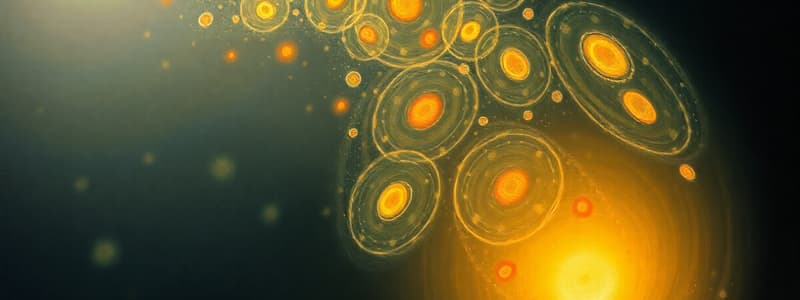Podcast
Questions and Answers
What significant evolutionary adaptations did plants, fungi, and animals develop for life on land around 500 million years ago?
What significant evolutionary adaptations did plants, fungi, and animals develop for life on land around 500 million years ago?
- Eyes, fins, and furrowed roots
- Lungs, limbs, and vascular systems (correct)
- Wings, gills, and exoskeletons
- Fur, feathers, and scales
What percentage of marine species were wiped out during the Permian Extinction event?
What percentage of marine species were wiped out during the Permian Extinction event?
- 50%
- 96% (correct)
- 70%
- 90%
What primary factor is accelerating species loss and raising concerns about a potential sixth mass extinction?
What primary factor is accelerating species loss and raising concerns about a potential sixth mass extinction?
- Asteroid impacts
- Volcanic eruptions
- Human activities such as habitat destruction (correct)
- Natural climate change
Which event allowed mammals to dominate after the extinction of dinosaurs?
Which event allowed mammals to dominate after the extinction of dinosaurs?
What phenomenon can result from mass extinctions concerning surviving species?
What phenomenon can result from mass extinctions concerning surviving species?
What was likely the first genetic material according to the RNA World Hypothesis?
What was likely the first genetic material according to the RNA World Hypothesis?
Which process describes the formation of simple organic molecules on early Earth?
Which process describes the formation of simple organic molecules on early Earth?
What significant event is marked by the activity of photosynthetic bacteria around 3.5 billion years ago?
What significant event is marked by the activity of photosynthetic bacteria around 3.5 billion years ago?
What describes the process by which eukaryotic cells evolved from prokaryotes according to the Endosymbiont Theory?
What describes the process by which eukaryotic cells evolved from prokaryotes according to the Endosymbiont Theory?
What factor is NOT part of the early Earth's atmosphere?
What factor is NOT part of the early Earth's atmosphere?
What is essential for the compartmentalization necessary for life in protocells?
What is essential for the compartmentalization necessary for life in protocells?
When did multicellular organisms first emerge?
When did multicellular organisms first emerge?
What event is characterized by the rapid evolution of most major animal groups?
What event is characterized by the rapid evolution of most major animal groups?
Flashcards
Mass Extinction
Mass Extinction
A major event in Earth's history where a large proportion of species go extinct in a relatively short period.
Permian Extinction
Permian Extinction
The most severe extinction event in Earth's history, killing approximately 96% of marine species around 252 million years ago.
Cretaceous Extinction
Cretaceous Extinction
Mass extinction event that occurred approximately 66 million years ago, marking the end of the dinosaur era and allowing mammals to diversify.
Adaptive Radiation
Adaptive Radiation
Signup and view all the flashcards
Potential Sixth Mass Extinction
Potential Sixth Mass Extinction
Signup and view all the flashcards
Early Earth Atmosphere
Early Earth Atmosphere
Signup and view all the flashcards
Miller-Urey Experiment
Miller-Urey Experiment
Signup and view all the flashcards
Protocells
Protocells
Signup and view all the flashcards
RNA World Hypothesis
RNA World Hypothesis
Signup and view all the flashcards
Stromatolites
Stromatolites
Signup and view all the flashcards
The Oxygen Revolution
The Oxygen Revolution
Signup and view all the flashcards
Endosymbiont Theory
Endosymbiont Theory
Signup and view all the flashcards
The Cambrian Explosion
The Cambrian Explosion
Signup and view all the flashcards
Study Notes
Early Earth and Protocell Formation
- Early Earth conditions supported the formation of small organic molecules from non-living matter.
- These molecules linked to create larger molecules like proteins and nucleic acids.
- Protocells formed when these macromolecules enclosed themselves within membranes that allowed for basic life functions, like metabolism.
- RNA, capable of both storing information and catalyzing replication, likely acted as the first genetic material.
Key Events in Life's History
- Life originated around 3.5 billion years ago as single-celled organisms.
- Photosynthetic bacteria, as evidenced by stromatolites, were prominent 3.5 billion years ago, increasing oxygen in the atmosphere around 2.5 billion years ago.
- Eukaryotic cells, containing organelles like mitochondria, are hypothesized to have evolved from prokaryotes through engulfment (endosymbiosis theory).
- Multicellular life appeared around 1.5 billion years ago.
- The Cambrian Explosion, around 535 million years ago, saw the rapid evolution of many animal groups.
- Plants, fungi, and animals colonized land around 500 million years ago.
Mass Extinctions
- The Permian Extinction (252 million years ago) wiped out nearly all marine species.
- The Cretaceous Extinction (66 million years ago) marked an end to the age of dinosaurs and allowed mammals to thrive.
- Current human activity poses a threat of another mass extinction.
- Extinctions can lead to adaptive radiation, where surviving species diversify and fill empty ecological niches.
Studying That Suits You
Use AI to generate personalized quizzes and flashcards to suit your learning preferences.




